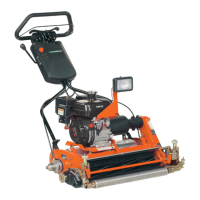ELECTRICAL
4203780 First Edition 4-53
4
Instrumentation Circuit—Theory of
Operation
Unswitched Power Circuit
Unswitched power is available from the battery positive
terminal to the starter motor battery terminal and then
from the starter motor battery terminal to 50-amp circuit
breaker (F1) battery terminal. Unswitched power is
available through the 50-amp circuit breaker (F1) to
30-amp circuit breaker (F2) input terminal and from
circuit breaker (F2) input terminal to 10-amp circuit
breaker (F5).
Unswitched power is available from 30-amp circuit
breaker (F2) output terminal to accessory relay terminal
30.
Unswitched power is provided from 10-amp circuit
breaker (F5) to PTO switch terminal E and then from
terminal E to time delay relay +12V terminal.
Interlock Circuit
The interlock circuit provides 12 volts to the key switch.
The following must occur before the key switch is
provided with 12 volts:
• PTO switch in the off position
• Park brake switch in the on position
With the PTO switch in the off position and park brake
switch in the on position, voltage is provided from the
park brake switch to key switch terminal B.
Switched Power Circuit
When the key switch is turned to the run position, voltage
is provided from key switch terminal I to accessory relay
terminal 86, energizing the relay. With the relay
energized, switched power is provided from accessory
relay terminal 87 to 10-amp circuit breaker (F6) and
10-amp circuit breaker (F4).
Switched power is provided from 10-amp circuit breaker
(F6) to horn relay terminals 30 and 86.
Switched power is provided from 10-amp circuit breaker
(F4) to the gauges and the indicator lights.
Volt Meter
Voltage is provided from 10-amp circuit breaker (F4) to
the volt meter. The volt meter indicates the condition of
the battery.
Engine Temperature Gauge
The engine temperature sensor resistance changes in
relationship to the engine coolant temperature. As the
engine temperature sensor is heated, the resistance of
the sensor changes from a high resistance to a low
resistance. The amount of resistance in the circuit
controls the amount of current flowing through the engine
temperature gauge. The amount of current flowing
through the circuit is indicated by the gauge as a
temperature measurement.
Tachometer
The engine speed sensor provides a signal relative to the
speed of the engine to the tachometer. The tachometer
indicates the speed of the engine on the gauge in rpms.
Hour Meter
The hour meter starts logging hours when switched
power is provided by the accessory relay.
Fuel Gauge
The float attached to the fuel level sender moves as the
fuel level changes to various levels. The resistance of the
fuel level sender changes in relationship to the position of
the float. As the resistance changes, the amount of
current flowing through the circuit changes and the
amount of current flowing is indicated by the fuel gauge.
Air Filter Service Light
When the air filter pressure switch is closed, a ground is
provided to the air filter service light, turning on the light.
Return Filter Service Light
When the return filter pressure switch is closed, a ground
is provided to the return filter service light, turning on the
light.
Hyd Oil Temp Light
When the hyd temp switch is closed, a ground is provided
to the hyd temp light, turning on the light.
Ground is also provided from the hyd temp switch
through diode (V6) to horn relay terminal 85, energizing
the relay. With the relay energized, voltage is provided
from horn relay terminal 87 to the horn, turning on the
horn.
Charge Filter Service Light
When the charge filter pressure switch is closed, a
ground is provided to the charge filter service light,
turning on the light.

